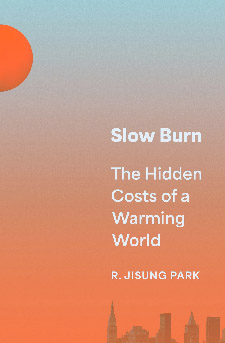R. Jisung Park takes us into a thought experiment. Suppose we shift attention away from the prospect of coming climate catastrophes – out-of-control wildfires, big rises in sea levels, stalling of ocean circulation currents – and we focus instead on the ways that rising temperatures are already having daily impacts on people’s lives around the world.
Might these less dramatic and less obvious global-heating costs also provide ample rationale for concerted emissions reductions?
Slow Burn by R. Jisung Park is published by Princeton University Press, April 2024.
Park is an environmental and labour economist at the University of Pennsylvania. In Slow Burn, he takes a careful look at a wide variety of recent research efforts, some of which he participated in. He reports results in several major areas: the effect of hotter days on education and learning; the effect of hotter days on human morbidity and mortality; the increase in workplace accidents during hotter weather; and the increase in conflict and violence as hot days become more frequent.
In each of these areas, he says, the harms are measurable and substantial. And in another theme that winds through each chapter, he notes that the harms of global heating fall disproportionately on the poorest people both internationally and within nations. Unless adaptation measures reflect climate justice concerns, he says, global heating will exacerbate already deadly inequalities.
Even where the effect seems obvious – many people die during heat waves – it’s not a simple matter to quantify the increased mortality. For one thing, Park notes, very cold days as well as very hot days lead to increases in mortality. In some countries (including Canada) a reduction in very cold days will result in a decrease in mortality, which may offset the rise in deaths during heat waves.
We also learn about forward mortality displacement, “where the number of deaths immediately caused by a period of high temperatures is at least partially offset by a reduction in the number of deaths in the period immediately following the hot day or days.” (Slow Burn, p 85)
After accounting for such complicating factors, a consortium of researchers has estimated the heat-mortality relationship through the end of this century, for 40 countries representing 55 percent of global population. Park summarizes their results:
“The Climate Impact Lab researchers estimate that, without any adaptation (so, simply extrapolating current dose-response relationships into a warmer future), climate change is likely to increase mortality rates by 221 per 100,000 people. … But adaptation is projected to reduce this figure by almost two-thirds: from 221 per 100,000 to seventy-three per 100,000. The bulk of this – 78 percent of the difference – comes from higher incomes.” (pp 198-199)
Let’s look at these estimates from several angles. First, to put the lower estimate of 73 additional deaths per 100,000 people in perspective, Park notes an increase in mortality of this magnitude would be six times larger than the US annual death toll from automobile crashes, and roughly two-thirds the US death toll from COVID-19 in 2020. An increase in mortality of 73 per 100,000 is a big number.
Second, it seems logical that people will try to adapt to more and more severe heat waves. If they have the means, they will install or augment their air-conditioning systems, or perhaps they’ll buy homes in cooler areas. But why should anyone have confidence that most people will have higher incomes by 2100, and therefore be in a better position to adapt to heat? Isn’t it just as plausible that most people will have less income and less ability to spend money on adaptation?
Third, Park notes that inequality is already evident in heat-mortality relationships. A single day with average temperature of 90°F (32.2°C) or higher increases the annual mortality in South Asian countries by 1 percent – ten times the heat-mortality increase that the United States experiences. Yet within the United States, there is also a large difference in heat-mortality rates between rich and poor neighbourhoods.
Even in homes that have air-conditioning (globally, only about 30%), low-income people often can’t afford to run the air-conditioners enough to counteract severe heat. “Everyone uses more energy on very hot and very cold days,” Park writes. “But the poor, who have less slack in their budgets, respond more sparingly.” (p 191)
A study in California found a marked increase in utility disconnections due to delinquent payments following heat waves. A cash-strapped household, then, faces an awful choice: don’t turn up the air-conditioner even when it’s baking hot inside, and suffer the ill effects; or turn it up, get through one heat wave, but risk disconnection unless it’s possible to cut back on other important expenses in order to pay the high electric bill.
(As if to underline the point, a headline I spotted as I finished this review reported surges in predatory payday loans following extreme weather.)
The drastic adaptation measure of relocation also depends on socio-economic status. Climate refugees crossing borders get a lot of news coverage, and there’s good reason to expect this issue will grow in prominence. Yet Park finds that “the numerical majority of climate-induced refugees are likely to be those who do not have the wherewithal to make it to an international border.” (p 141) As time goes on and the financial inequities of global heating increase, it may be true that even fewer refugees have the means to get to another country: “recent studies find that gradually rising temperatures may actually reduce the rate of migration in many poorer countries.” (p 141)
Slow Burn is weak on the issue of multiple compounding factors as they will interact over several decades. It’s one thing to measure current heat-mortality rates, but quite another to project that these rates will rise linearly with temperatures 30 or 60 years from now. Suppose, as seems plausible, that a steep rise in 30°C or hotter days is accompanied by reduced food supplies due to lower yields, higher basic food prices, increased severe storms that destroy or damage many homes, and less reliable electricity grids due to storms and periods of high demand. Wouldn’t we expect, then, that the 73-per-100,000-people annual heat-related deaths estimated by the Climate Impact Lab would be a serious underestimate?
Park also writes that due to rising incomes, “most places will be significantly better able to deal with climate change in the future.” (p 229) As for efforts at reducing emissions, in Park’s opinion “it seems reasonable to suppose that thanks in part to pledged and actual emissions cuts achieved in the past few decades, the likelihood of truly disastrous warming may have declined nontrivially.” (p 218) If you don’t share his faith in economic growth, and if you lack confidence that pledged emissions cuts will be made actual, some paragraphs in Slow Burn will come across as wishful thinking.
Yet on the book’s two primary themes – that climate change is already causing major and documentable harms to populations around the world, and that climate justice concerns must be at the forefront of adaptation efforts – Park marshalls strong evidence to present a compelling case.







